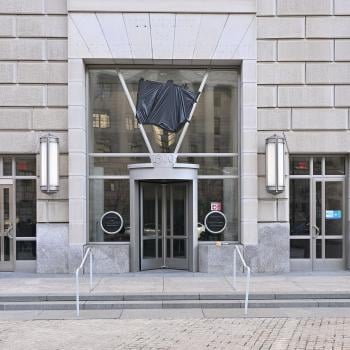Denomination of the Week: Beachy Amish
Hollywood and television routinely portray all Amish people as alike. They ride in black horse-drawn buggies and don’t own motor vehicle; the men wear beards and funny hats; the women wear plain dresses down to their ankles and with long sleeves; they all farm or make furniture; they live without electricity. Many people’s images of the Amish come from movies like “Witness” starring Harrison Ford as a big city detective who takes refuge with an Amish family and falls in love with their daughter (1985). And then there are the numerous Christian Amish romance novels packing the shelves of Christian bookstores. And then there are the television documentary shows about the Amish practice of “Rumspringa” which always focus on the Amish adolescents and early adults “partying.”
But not all Amish are alike. In fact, there is at least one denomination of Amish that uses electricity, drives motor vehicles, and owns cameras and computers (but not televisions or radios). They don’t fit the Hollywood-television-fiction stereotype of “the Amish.” They are called “Beachy Amish Mennonites.”
A few years ago I was driving on a country highway not far from where I live and happened to pass a modern-looking church whose sign said “Faith Mennonite Fellowship.” There aren’t a lot of Mennonites or other Anabaptists around here, so I looked the church up on the internet when I got home. I discovered it is a congregation of “Beachys”—Beachy Amish (who also sometimes call themselves Mennonites).
I made contact with an elder (by e-mail!) and eventually took one of my classes to the church on a field trip. Inside and outside it looks just like any smallish Baptist or other church. The elder and his wife sat and talked with us in the back of the sanctuary for an hour. They answered all our questions—emphasizing their similarities with but differences from “Old Order” Amish and Mennonites. We discovered this particular church, one of only a handful in the state, was founded as a mission to this region from Beachy Amish churches in Ohio.
Two years later I invited two elders of that Beachy congregation to my class—to talk about the Radical Reformation today. They arrived in plain dress—denim jeans and open collar shirts—and spoke plainly. They admitted that they never went to seminary and so were a bit nervous talking to a seminary church history/historical theology class. But after a few minutes everyone relaxed and they came across as not that different from country Baptists.
Beachy Amish history began around 1927 when an Old Order Amish bishop named Moses M. Beachy began separating himself and his followers from other Old Order Amish in Pennsylvania and Ohio. They are considered the most “progressive” of the Amish groups because of their acceptance of electricity, motor vehicles, computers, missionary work, etc. They are not as “separated” from the rest of society as other Amish, but neither are they modern Mennonites. Like all Mennonites and Amish they are pacifists and eschew holding government jobs that might entangle them in even remote association with violence. Like other Old Order Mennonites and Amish they emphasize “simple living.” For them, however, that does not mean avoiding everything of the modern industrial revolution; it means not participating in “conspicuous consumption” as promoted by advertising. The cars they drive are relatively inexpensive. The women wear no jewelry or makeup. On the other hand, they might live next door to you and own a small business in town.
The Beachy Amish describe their theology as “evangelical” and I found that to be true in my/our conversations with them. When visiting their church with my class I perused their hymnbook. I knew most of the hymns from childhood. (I often describe the Pentecostal church I grew up in as “urban Amish.” In the 1950s we frowned on television, strictly avoided movie theaters, and emphasized simple living.) They baptize repentant sinners, including their own youths, at around age sixteen—by pouring. They have “bishops” but their congregations are autonomous. The “denomination” is really just a network of congregations with no central headquarters, college or seminary. They practice foot washing as an ordinance alongside baptism and the Lord’s Supper.
All Amish groups can be traced back, as to their historical-theological roots, to the Radical Reformation of the sixteenth century and more specifically to the “Swiss Brethren” who, in 1525, began “re-baptizing” each other in Zurich. (The word “Anabaptist” simply means “re-baptizer.) The Swiss Brethren were reformer Ulrich Zwingli’s followers who thought he and other “magisterial reformers” were allowing civil governments to determine too much the course of the Reformation. They wanted to restore the primitive New Testament church; in their eyes and to their minds Luther, Zwingli and other mainline reformers were not sufficiently cleansing the churches of Catholic elements. They were persecuted, even killed, by both Catholics and Protestants. Many survived by hiding and moving around. The word “Mennonite” comes from the name of Menno Simons, a leading sixteenth century Dutch Anabaptist theologian and church leader. It was he, especially, who turned the Anabaptists toward pacifism.
The Amish branch of Anabaptists began with Swiss Anabaptist leader Jakob Amman who, in 1693, founded a new branch of the Swiss Brethren emphasizing separation from budding modernity and strict church discipline (“shunning”) of “brethren” who sinned without public repentance (to the elders, to the congregation). Many Amish fled European persecution to the “New World” where they tended to settle in Pennsylvania because of the Quaker/Friends there. Although their historical-theological roots are different, the Friends and Amish share pacifism and religious liberty (before that became the norm in either Europe or much of America).












